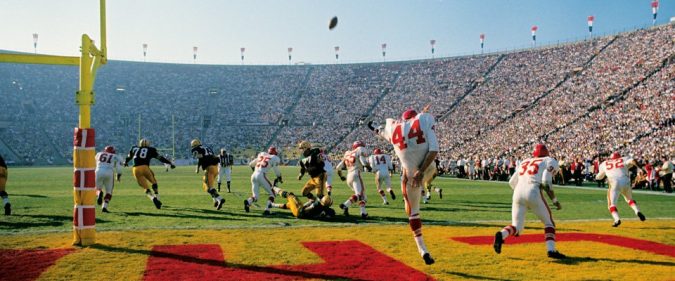The good people at Taschen have decided to show us more of sports photographer Neil Leifer’s work, and this is a very good thing. We’re in the thick of football season now, and I can think of no finer accompaniment than Leifer’s collection, Guts & Glory: The Golden Age of American Football, which tracks the NFL’s rise to the dominant sport in the country.
Leifer, a poor kid from the Lower East Side, was at Yankee Stadium on his 16th birthday when he snapped the picture of Alan Ameche scoring the winning touchdown against the Giants in the 1958 Championship. The photograph is the enduring image of the game that that put the NFL on the map. The Golden Age of American Football is a collection of Leifer’s work, as he went from precocious amateur to top of the heap at Sports Illustrated.
I spoke to Leifer on the phone last week to talk about the book.—AB
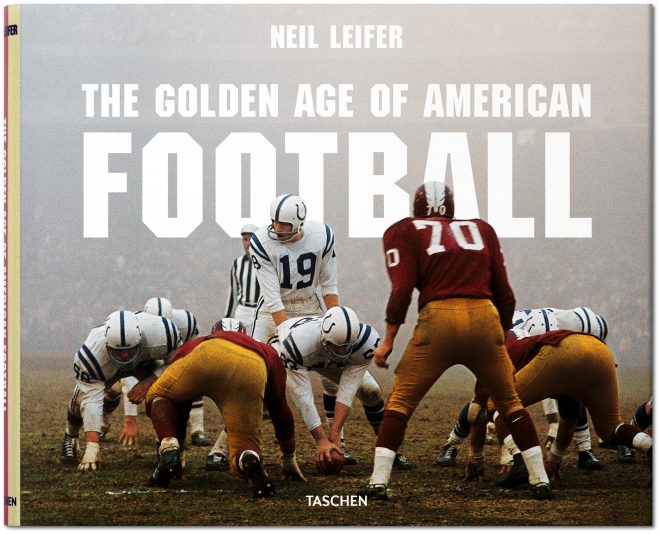
Alex Belth: I know you were a Brooklyn Dodgers fan. Were you also a football Giants fan?
Neil Leifer: I didn’t discover NFL football until probably 1957 or so. Remember, there was a period of time you could go to Yankee Stadium and buy a ticket to any Giant game. Don’t forget they had a winning season in ’56, although I wasn’t really into it at all then, but I knew they were winning. They had players like Frank Gifford and Charlie Conerly who I liked, and Pat Summerall. I don’t remember exactly what it was.
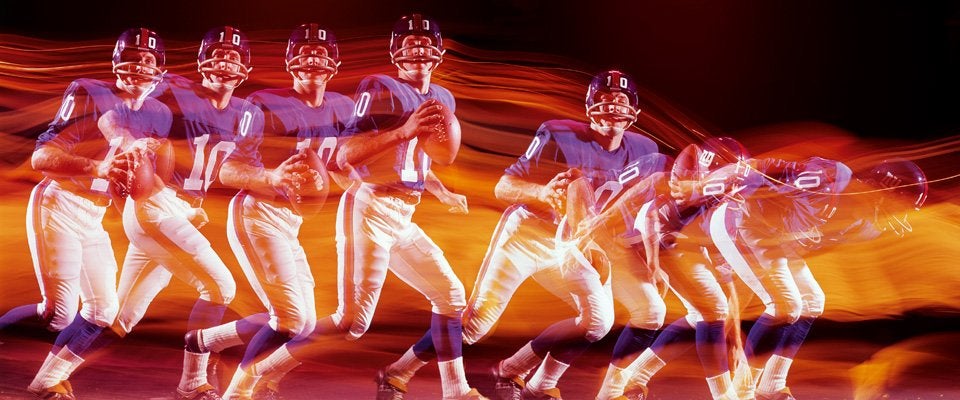
Alex: Did football appeal to you any more or less than the other sports from a visual perspective?
Neil: With me, I had just sort of gotten the photography bug and I was really enjoying shooting sports and this was another sport to shoot thatI thought would be fun. I went to Madison Square Garden. I went to see mainly the Rangers. I shot more hockey than basketball because you could get in those upper seats in Madison Square Garden, the cheap seats upstairs and actually shoot some pretty nice hockey pictures. You know, I grew up in a low-income housing project, I didn’t have fancy cameras or fancy lenses, I had basic stuff. A little better than a Brownie Hawkeye but not much better. I was a member of a camera club at the Henry Street Settlement, which is still there, believe it or not. Are you from New York?
Alex: Originally, yes, Upper West Side.
Neil: The settlement houses were designed for kids in rough neighborhoods—lot of drugs, lot of crime, at the time, lot of gangs—and they were designed to keep kids off the streets. So you could learn to play an instrument, you could learn to dance, you could play basketball. I wanted to go to play basketball but they didn’t let you do the same activity every day. I joined the camera club at the settlement and we had a wonderful teacher, who sort of inspired a lot of us: Johnny Iacona became a staff photographer at Sports Illustrated; Manny Millan also went there and was a photographer at Sports Illustrated; Vinnie Manfro became a staff photographer at Look magazine, along with a guy who calls himself Mickey Palmer—he was Mike Palmeiri then, and he became a style photographer at Look magazine. So we had a pretty successful little camera club, had a lot of guys who went on to become professional photographers.
Alex: Did you start taking pictures of sports because you liked them but also because you thought you could hustle some pictures and make some money?
Neil: I had no idea there was a profession called photojournalism, quite frankly. And what 13 year-old kid is thinking about making a living? You know, my parents thought they had a young doctor or lawyer on their hands. They certainly didn’t expect this. But it just developed. Suddenly one day I discovered people were paying me to go to sporting events, putting me in the best seat in the house and paying me for something that I enjoyed doing. Talk about being lucky and in the right place at the right time, really. My credit is that I capitalized on it.
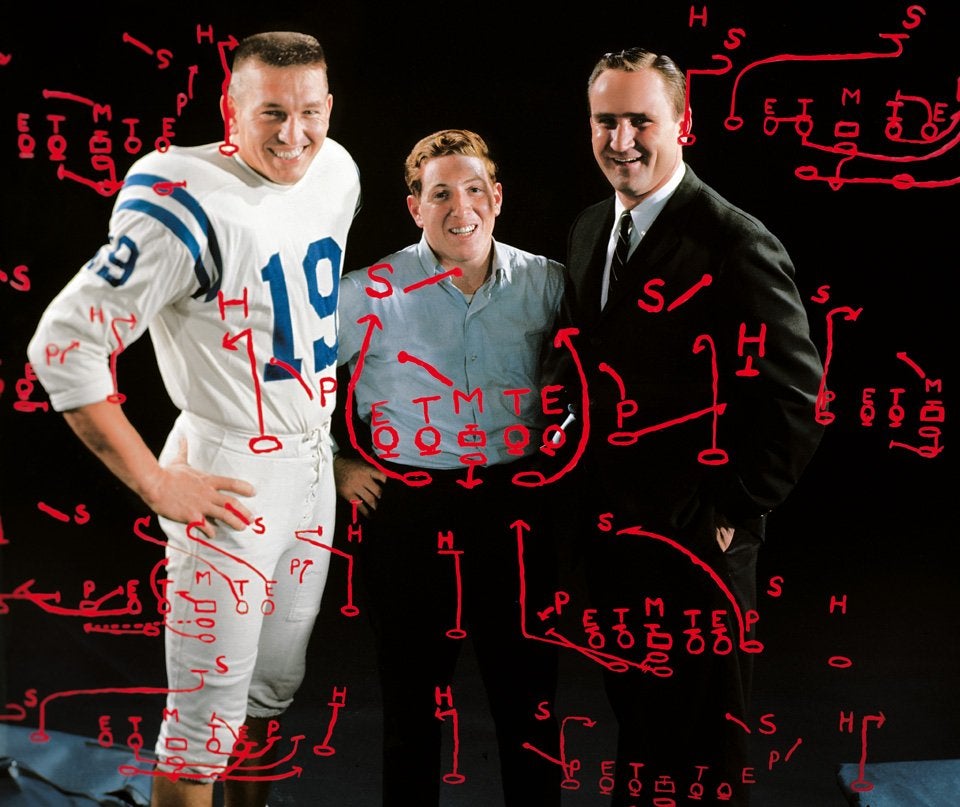
Alex: So what about football is special to you compared with the other sports?
Neil: Once I started really shooting football, when I had some decent equipment … look, one of my best-known football pictures was taken with my little Yashica Mat on my 16th birthday. And had I had a good camera I would have come in closer to Alan Ameche scoring that touchdown, rather than the wide shot that I got, which is better than any close-up could ever have been.
Alex: The technical limitation resulted in a better picture.
Neil: The fact is once I started shooting football, I got hooked on how great it was for photography. Let me digress slightly and say by comparison to baseball for example, where half the time you fall asleep. You know, yeah, it makes a great picture when the second baseman is leaping over the sliding runner on a double play, trying to get the ball to first base. It’s fabulous when you get a slam-bang play at home plate, but half the time—take a good pitcher’s duel. What do you photograph? You sit there waiting for something to happen. Football, there’s a potential photograph on every single play.
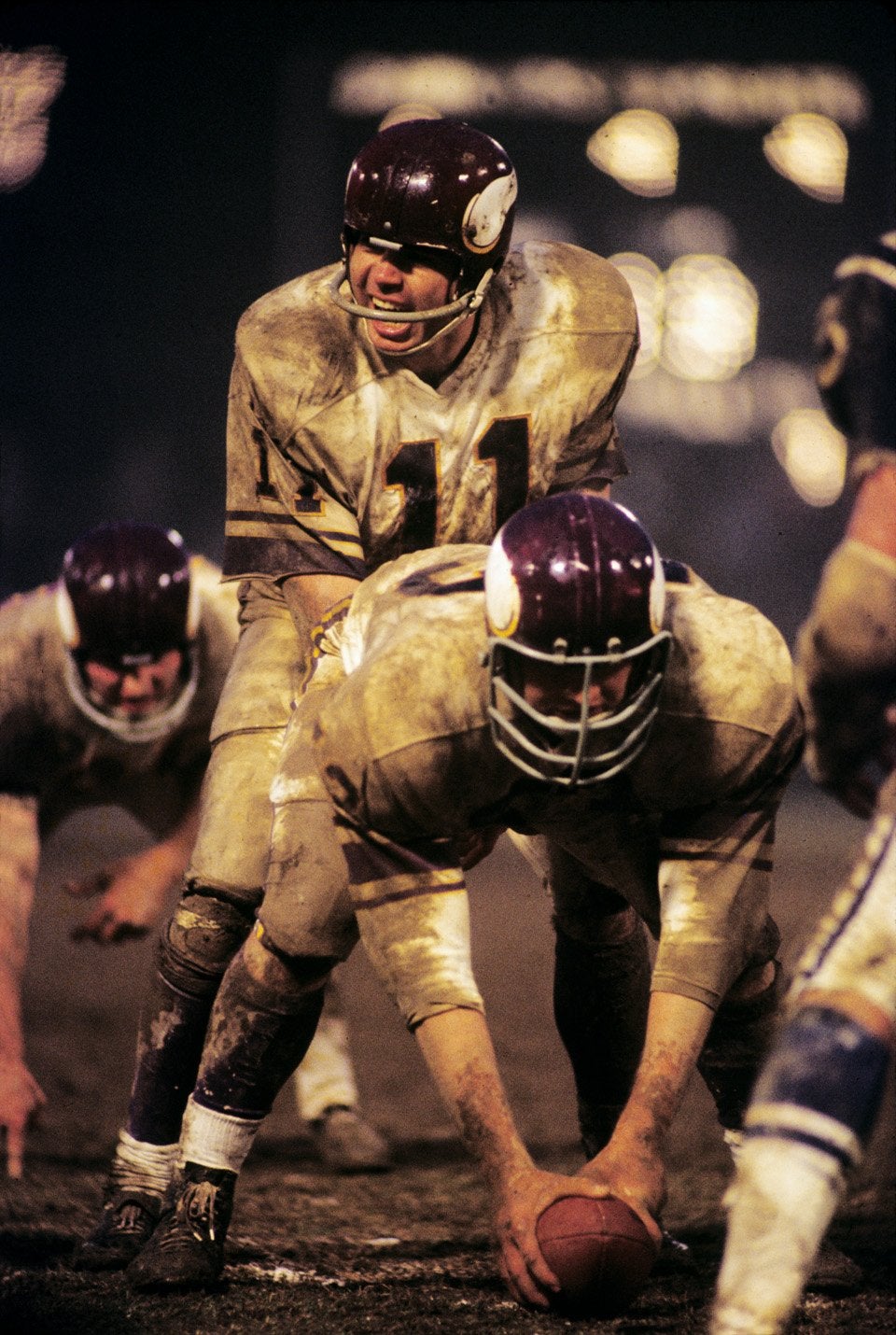
Alex: And then add the element of bad weather.
Neil: The most interesting thing about football that comes through in the Football book loud and clear—it’s what I like most about the Football book—is the weather. The cover of the book is Johnny Unitas in the fog. Look at Jimmy Brown in the mud against the 49ers. There are some black-and-white photos of Y.A. Tittle, where you can barely see the number on his uniform. Remember in those days they played mostly in baseball stadiums, so once it rained the infield just became mud. To say nothing of the fact that there was no Astroturf. The grass….Today’s football pictures aren’t nearly as exciting as the old ones because the fourth quarter looks every bit the same as the first quarter. Take a look at the Super Bowl pictures. Look at the white pants. There’s not even any grass stains. Whereas look at my book, look at Joe Namath on the phone in the mud from head-to-toe. Look at the portrait of Sam Huff with a chunk of turf coming out of his helmet, the Minnesota Vikings breathing so you can see how cold it was, and of course snow—how can you beat it?
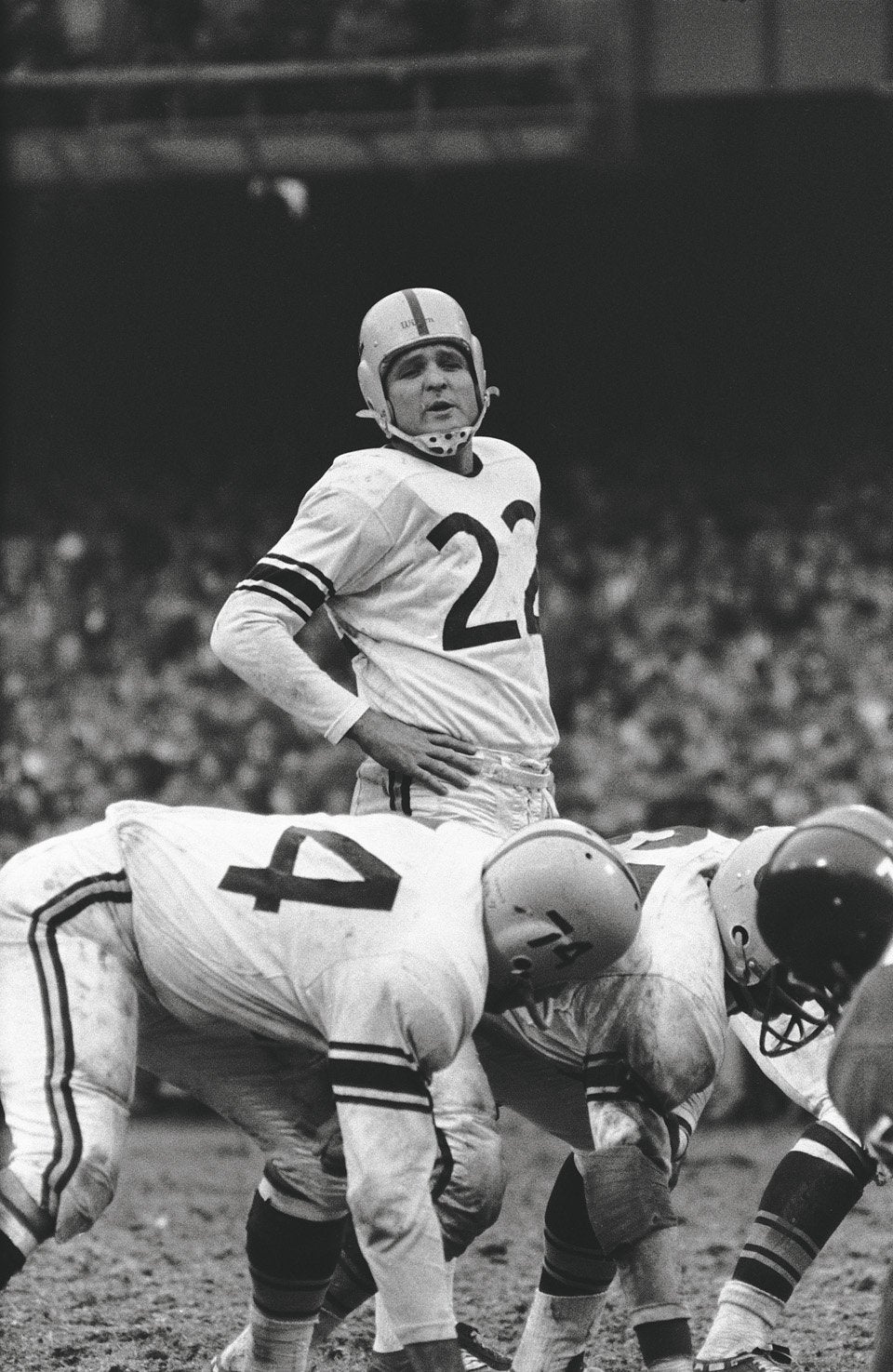
Alex: Visually, it has a narrative, dramatic, arc.
Neil: Boxing is the same thing—the fighters don’t look the same in the fifth round or the eight or tenth round. Plus the fact there is potentially a photograph with every jab thrown. Football is very exciting to photograph. But that wasn’t a factor when I started.
Alex: Did you move around to different locations during the course of a game?
Neil: Oh, of course. And today’s photographers do as well. Except for the fact that photographers were not—and are still not—permitted in front of the bench. You’re not permitted between the 30 and the 30-yard lines. You could be on the rest of the field as long as you’re out of bounds. Occasionally, I would get permission from a team to be in front of the bench. I shot some pictures in front of the bench more than once. That was always up to the coach. But 99 percent of the pictures are from the sideline. The ball moves up and down the field, the photographers move up and down the field. That’s the same today.
Alex: How competitive was it with other photographers to get the position you wanted? Was there a hierarchy?
Neil: We were competitive in that every big game had more than one photographer covering it, and only one could get the cover story or the opening spread. But at the game, the truth is, who knows where the play is going to go? Even today at the Super Bowl where it’s very crowded there’s enough room to get the position you want. The fact is you never know which way the ball is going to go. That’s always a coin toss.
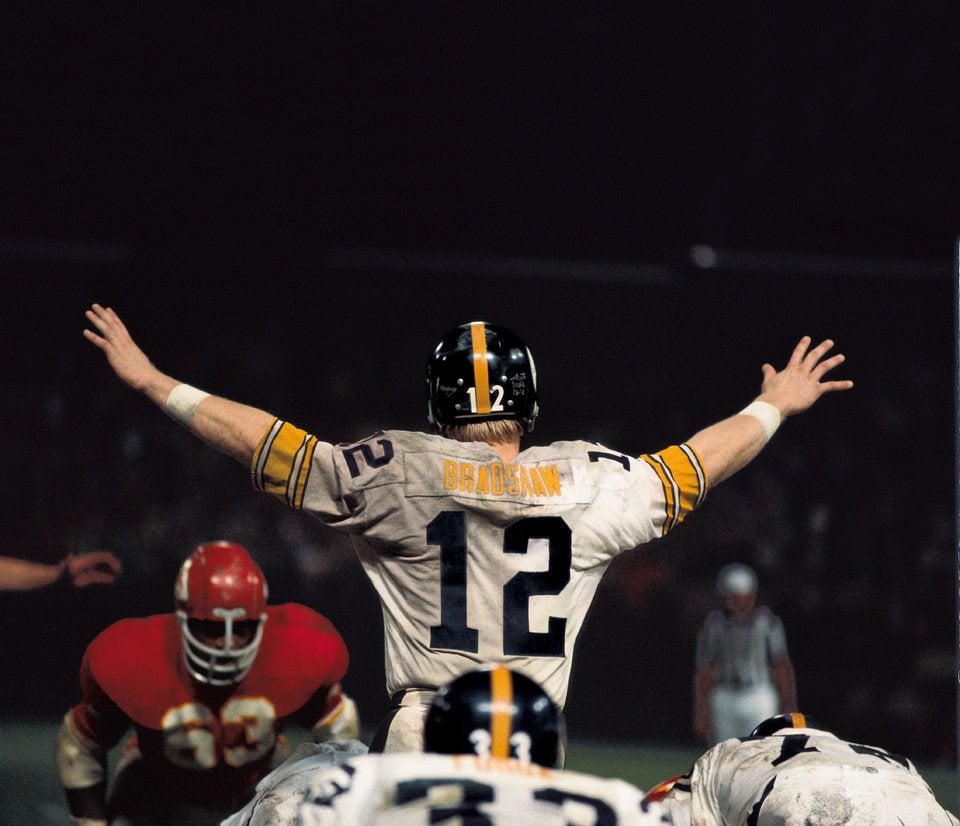
Alex: Were there particular Stadiums you liked working?
Neil: Yeah, listen. There is nothing like horrible weather day for pictures but who the hell wants to work in it? You always dream of being in 75 degrees on a beautiful day with the sun out. So yeah, I always wanted to go to L.A. or San Francisco. Except half the time I went to San Francisco it would pour rain at Kezar Stadium—which became a quagmire. Look at the Jimmy Brown running picture and you’ll really see it there. Most of the time I went to San Francisco, my luck it would rain. But you still wanted to go to Kezar Stadium. They played in those beautiful red uniforms, the field was always bathed in sun—except when I went there. But if you covered a game in the L.A. Coliseum it was 75-80 degrees, you were in short-sleeves. Who wants to be slogging through a frozen day? Try to load cameras when it’s pouring rain. But, the pictures you got on those rainy days were always so much better.
Alex: And even if bad weather was a grind you clearly had a strong constitution for it.
Neil: Well, number one, you want to make a living. Football was becoming the biggest sport. Number two, it’s not a high tolerance, you had no choice. If you go to work at Sports Illustrated and covered football, you damn well had to be able to work in the cold and the wind and the snow and whatever the conditions are. Listen, nothing is as boring as the Superdome in New Orleans. Or there used to be the Astrodome in Houston. There are so many indoor Stadiums now, where no matter what the weather is outside, it’s going to be 75 degrees inside and flat light.
Alex: I was really taken by the old baseball parks, particularly Yankee Stadium.

Neil: Oh, the Stadium was a great place to photograph football.
Alex: It was so cavernous; it was like an opera house.
Neil: It’s the same thing as the weather. The stadiums were far more interesting to shoot in then. Far more. They had character. Today, all the stadiums are just boring. They’re all wonderful with their luxury boxes but the stadiums then had real character. The Chicago Bears played at Wrigley; the Steelers played at Forbes Field. They were wonderful backgrounds. Hey, I was never a Yankee fan but I loved shooting at Yankee Stadium. I mean, how could you miss? Baltimore was a favorite of mine, too. There were very nice to deal with. Coach Shula was a pleasure. There’s one picture where he’s addressing the team in practice, in a classroom setting, and Johnny Unites and Earl Morrall were sitting down in front. You just don’t get that kind of access. Both the Orioles and the Colts for whatever reason were extremely accessible and very pleasant to deal with.
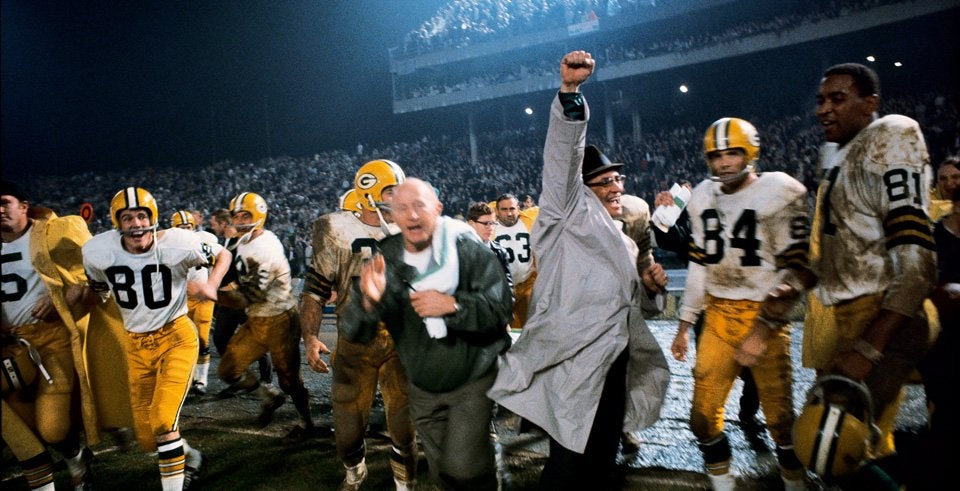
Alex: What guys did you love photographing?
Neil: I loved the Green Bay Packer teams. Those great Green Bay years—even though I also hated the Packers because they kept beating my Giants—Lombardi’s years with Paul Hornung and Bart Starr and Jimmy Taylor and Ray Nitschke, how could you not get hooked on the sport? Dick Butkus was a particular favorite of mine, and I loved the old Giants—Y.A. Tittle was my first cover, so I’m very partial to Tittle. Jimmy Brown was unreal to photograph because he just made great pictures, and I hate to put him in the same breath, but so was O.J. Simpson. O.J. Simpson was beautiful to photograph.
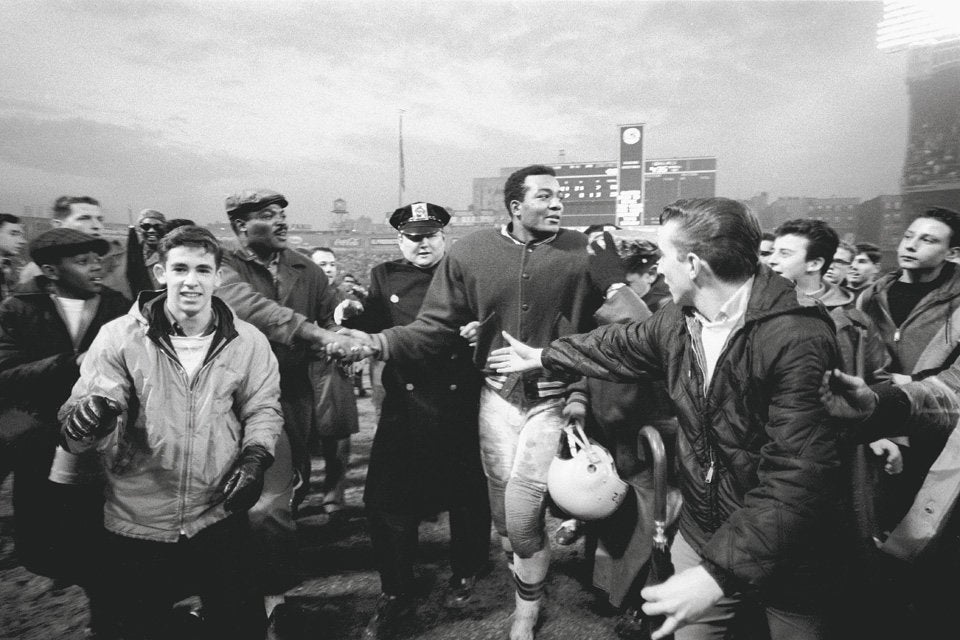
Alex: What were football players like compared with boxers or baseball players?
Neil: Remember, I was working for a magazine that had a circulation of over three-and-a-half-million a week. So most teams—and players then were a lot easier to deal with, you weren’t dealing with agents and publicists. For the most part, it’s hard to generalize….My usual answer is that boxers have always been to me the nicest people in sports. Generalization. Doesn’t mean you don’t run into some asshole every once in a while, but most of the boxers were a pleasure to be with. But most of my pictures were action shots, nine-out-of-ten times I didn’t hang out with them. The only time I met players is when they came to pose in the studio for the cover. There are a number of posed pictures in the book. Sports Illustrated had a lot of clout and most players were delighted. The idea of being on the cover of Sports Illustrated was a good thing, both for them and for the magazine. They liked it.
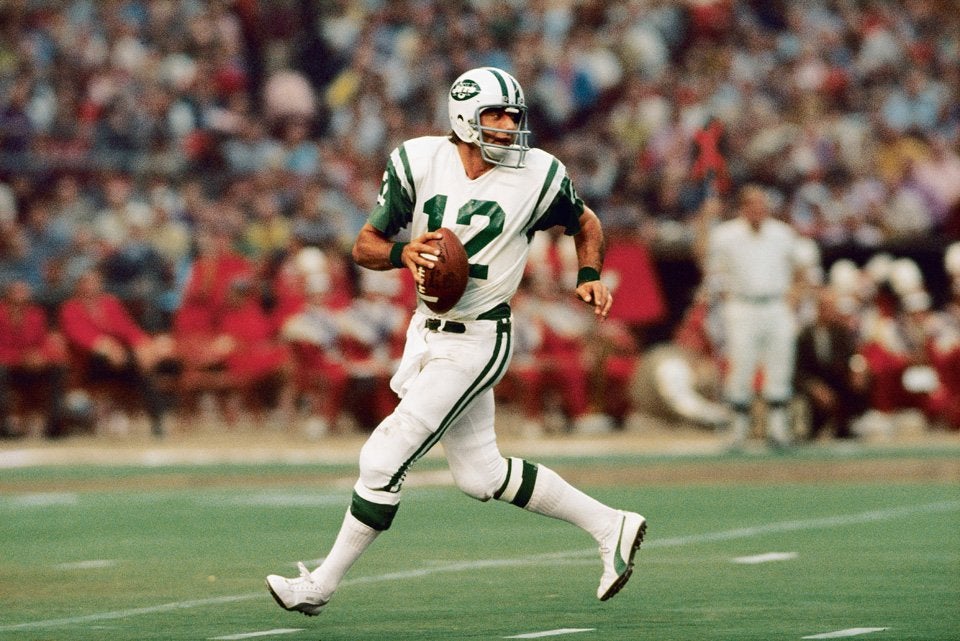
Alex: Did you have the sense that the NFL had taken over as the country’s most popular sport?
Neil: I probably never really thought about it. Hey listen, there were empty seats at the first Super Bowl. By the time the Jets played the Colts in Super Bowl III—and the only reason the stadium was full was because it was in Miami was because it was a New York team. But after that? Try buying tickets to a Super Bowl today. No, you couldn’t miss it. It was impossible to miss the power of the game.
[All photos courtesy of Taschen]
